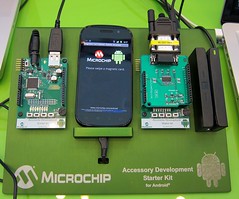You got the tip from me from an anonymous source here since January (I have been speculating about it (2) (3) (4) for over a year), clues about it from ARM President Tudor Brown last year in November, and re-confirming rumors through Samsung in February, Google announced at Google I/O this week that Ice Cream Sandwich combines Android, Honeycomb and Google TV into one release (thus Google TV features on ARM), now it’s being reported by PC World that Google TV product manager Rishi Chandra is confirming the ARM Powered Google TV platform like this:
for the price issue, Chandra said that Google has now qualified ARM chips to be used to run the Google TV software, instead of just the Intel Atom chips that currently power the Revue. Moore’s Law–the inevitable increase in chip performance driven by increasing transistor density–will push the performance of the cost-optimized ARM chips up high enough to compete with Atom, while helping drive down the overall platform price, Chandra said.
I have thus far video-blogged over 60 ARM Powered Set-top-boxes from all the consumer electronics trade shows over the past 2 years, most are running Android, all of which could in theory run the Google TV software.
Of course, it is up to Google to decide what kind of hardware requirements they want to enfore for Google TV on ARM, if they want those to only feature the full suite of HDMI pass-through features, meaning HDMI input and output, Infrared blasters (to change the channel on your cable/satellite set-top-box), USB hosts, Bluetooth and more, then that would disqualify just about all of the ARM Powered set-top-boxes that I have filmed thus far. I wouldn’t know how much more those hardware features require, and perhaps that requires an ARM Cortex-A9 at the minimum to run all the overlay user interface features and preferably 1080p at 60fps support at the minimum.
I think it is more likely and more logical that Google will decide to be as open as possible about Google TV on ARM, and thus support all the SoC that are currently being used and that will most likely be used. I think that means Google TV on ARM could work in “AppleTV/Roku mode”, meaning no HDMI inputs, just the Google TV experience of bringing the Web and WebTV on the TV on this separate HDMI port to your HDTV. That is why I expect there to be two kinds of Google TV on ARM:
1. Basic Google TV on ARM, this is HDMI output only, Bluetooth or RF/USB keyboards with mouse pad accessory can be used. This solution could work on 100% of the ARM Powered Set-top-boxes that I have filmed. And I believe this will be included turning every Android Smartphone/Tablet with Ice Cream Sandwich and every Tablet with Honeycomb 3.1 into a Google TV “for free”. See the Google Android Team’s response to my question submitted on the possibility of turning all Android devices into free Google TV devices when HDMI is used:
2. The Full ARM Powered Google TV experience, including HDMI pass-through, IR blaster, USB hosts, Ethernet, etc.. Since Chris DiBona answers to my question above “There’s all this other stuff that goes into a Google TV that isn’t in a phone”, well then, the Full ARM Powered Google TV will be that type that does it all. But that should not prevent an Android device with a basic HDMI output and not much else to still display many if not most of the Google TV UI features right there on the HDTV.
3. There is also a third scenario that I am envisioning, Google might use their Android Hardware division to plan out a new type of Multimedia TV Docking system for Android, using nothing more than HDMI, USB slave/host and evt MHL (that combines both into one Micro-USB connector). Basically the idea here is a cheap TV Dock that should work with most if not all Android Smartphones that have HDMI, USB (or MHL) to turn those into full Google TV, thus using the USB slave/host to transmit the right infos back and forward and feature in that Dock the right HDMI input and output, IR blaster, USB host duplicators, Ethernet connector, charging and more. The idea is a new Google Open Accessory design that could sell for $49 to dock any Android Smartphone with HDMI/USB or MHL and thus turn those into full Google TV. A solution which could evt also turn any ARM Powered Set-top-box into a full Google TV box also with adding the HDMI in/out, IR and more to those. Maybe it could be called the Google TV adapter, converter or extender.
Here’s the 56 minute session on some of the Google TV Honeycomb 3.1 upgrades and development tools at Google I/O:
Related articles
- 3 things Google TV needs from Google I/O in 4 days (armdevices.net)
- What to expect from Google I/O May 10-11th (armdevices.net)
- Impressions from the Google I/O Android Keynote, Day 1 (armdevices.net)
- ARM Powered Google TV by Samsung rumored by Bloomberg (armdevices.net)
- What’s Google TV’s Key Selling Point? (slashgear.com)
- You: What the New Google TV with Honeycomb Looks Like [Google] (gizmodo.com)































